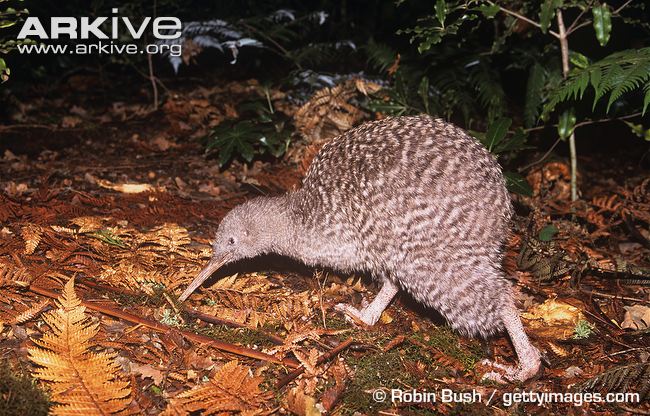
Apteryx haastii
TAXONOMY
Apteryx haastii Potts, 1872, Westland, New Zealand.
OTHER COMMON NAMES
English: Great gray kiwi; French: Kiwi roa; German:
Haastkiwi; Spanish: Kiwi Moteado Mayor.
PHYSICAL CHARACTERISTICS
Length 17.7–19.7 in (45–50 cm); males 2.6–5.7 lb (1.2–2.6 kg),
females 3.3–7.3 lb (1.5–13.3 kg). Medium-sized, flightless, nocturnal
bird with pale, mottled-gray, shaggy plumage. The body
is pear-shaped with a long neck and bill. Females larger than
males, and with longer bills. Larger than the little spotted kiwi
and about the size of the brown kiwi.
DISTRIBUTION
Two isolated populations in the northwest of South Island, in
Nelson and Westland.
HABITAT
Densest population above 2,000 ft (700 m) in wet beech forest
in mountain ranges running parallel to the coast. Also in tussock
grassland, podocarp, and hardwood forests, and sometimes
in coastal pasture.
BEHAVIOR
Nocturnal, pairs holding territories of about 49 acres (20 ha)
or more. Most displays are vocal, using high-pitched whistles
that have distinct male and female versions—the male shriller
than the female. Roost in dens during the day, into which
some vegetation is taken by the bird to form a small mat. A
kiwi may have 100 dens in its territory, using a different one
each day.
FEEDING ECOLOGY AND DIET
Omnivorous, but eats mostly soil and litter invertebrates, such
as earthworms, millipedes, and larval beetles, as well as moths,
crickets, and spiders, supplemented with some fruit. Crayfish
are eaten when they leave flooded streams, and some food is
taken above the ground when the bird can walk out along leaning
branches.
REPRODUCTIVE BIOLOGY
Pairs maintained for life with some indication of polyandry in
lowland populations. Mostly nest in natural hollows and sheltered
places, but a few nests are in short burrows dug by the
pair. Some moss lichen, leaves, and twigs are gathered to form
a thick nest. Most clutches are composed of one egg, but two
eggs have been reported. Both sexes incubate, usually the male
by day and the female by night. The incubation period is not
known.
CONSERVATION STATUS
Endangered, declining in lowland forests and vulnerable to
traps set for possums and to attacks by dogs.
SIGNIFICANCE TO HUMANS
None known.
Other popular Animals
Photo Gallery of - Great spotted kiwi




 Animalia Life
Animalia Life